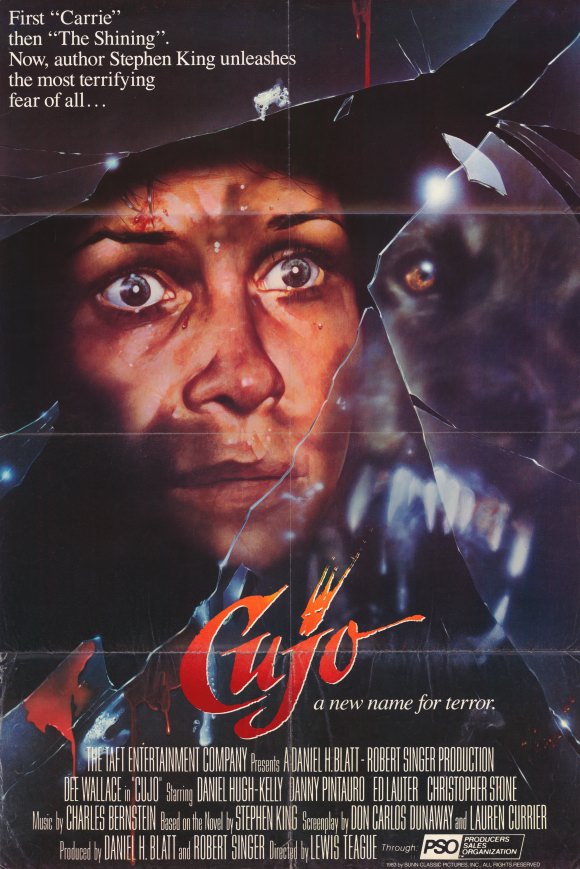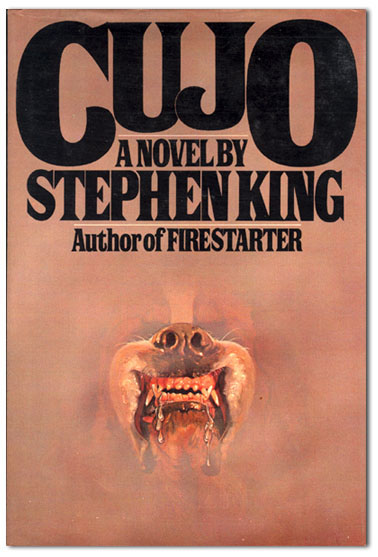
Day 2 of Dee Wallace Week brings me to reflect on the novel Cujo and my special relationship with it. Lewis Teague adapted it, and Dee gives what may be her bravest performance.
Stephen King’s novel Cujo will always have a special place in my life. It’s the first long adult novel I ever read, and at the time I found it a great read. It took me over a month to get through, and although it doesn’t hold up quite so well (I’ll get back to this point), it kept my pre-teen interest through to make it through to the end. More importantly, it inspired me to read more, and is probably a big part of why I became such an avid reader, and eventually an English teacher. I remember the cover, which showed the snarling, drool dripping jowls of a St. Bernard emerging from the mist, and how excited I was every time Mom took me back with her to the rundown little used bookstore by Lake Ronkonkoma. I had to see what new horrors awaited.

Because of this, my relationship with Lewis Teague’s film version CUJO is unique. It’s become impossible for me to judge it with the same standards I apply not only to any other horror movie, but any other movie. When I first saw it, I was still young, and I remember it being hugely disappointing. I’d been excited at the prospect of a movie version, but walked away feeling ripped off by a lightweight version of King’s story. I now understand why I made this judgment: the film lacked the depth of the book. Certain character details were eliminated, some events compressed or deleted entirely. I was ignorant to just how necessary all of that is to fit hundreds of pages into 95 minutes of film. Only years later, when I saw CUJO as an adult, I was able to see it on realistic terms own terms. CUJO is still is not a great movie. It bogs down at times and plays like a “Stephen King Lifetime Movie of the Week” at others. But it does offer some decent scares, and rides on the superior acting of Dee Wallace. And there’s that terrible dog.
CUJO introduces the audience to a 200 lb. dog, chasing a rabbit across a field. In a demented twist on Alice in Wonderland, the rabbit leaps down a hole, and Cujo jams his head in. The actions stirs up a group of bats, one of which bites the St. Bernard on the nose. The repercussions of that small bite will cause terror for the townsfolk of Castle Rock, Maine.
Played against this is the family drama of the Trentons. Wife Donna is bored with living in rural Maine, and has engaged in an affair with the local tennis bum (okay, admittedly I’ve never lived there, but how many local tennis bums do you find in rural Maine?); husband Vic’s position as man of the house is threatened not only by the affair, but a disastrous turn of events at his job in advertising. Amid all this turmoil, son Tad fears the monster in the closet (a nice reference to King’s novel The Dead Zone in the novel). Car troubles bring Donna and Tad to the Camber farm, where mean bastard Joe lives with his wife Charity and son Brett, and Cujo. The Cambers have their own family problems, so when Charity wins some money in a lotto, she works Joe into letting her go to see family, leaving him alone with a dog that is about to turn into a rabid killing machine. When Donna’s Pinto breaks down at Camber’s farm, she has to struggle not only against Cujo, but a car that is quickly becoming an oven in the summer heat.
Looking at CUJO now, I find it’s actually a benefit that the movie streamlines the action. The book bounces between three different storylines, and there are long spans where nothing really happens. Long passages about Vic’s job problems and Charity’s means of escape stall things terribly. Wisely, the movie eschews these subplots, and once the siege begins, the cutaways are short. The setup before the siege still takes way too long (you can blame King for this; he’s not one to cut to the quick), and much of the tension between Vic and Donna falls flat, mainly because Hardcastle and McCormick’s Daniel Hugh Kelly isn’t up to the scenes (though Wallace’s real life husband Christopher Stone is awesomely sleazy as the tennis bum). But if the novel had moved this quickly, I guarantee that even at age 11 I’d have made it through in much less than a month.
Even taken on its own, CUJO would have failed miserably if it didn’t have a strong actress playing Donna Trenton. Long stretches of the movie take place in a car with just a mother and her 6-year-old son. With the wrong actress, this would’ve been disastrous, maybe even unwatchable. With Dee Wallace, it’s absolutely compelling. Her overwhelming concern is to fight for the life of her son, and Wallace brings the courage and determination my own mom would have. Her portrayal is gutsy and realistic, especially when she gets fed up with Tad at one point and blows up at him. Her performance is profound and moving, so much so that King himself said on a TCM special last October that he thinks she should have won an Oscar. I can’t disagree with him here. She’s a solid actress, a credit to the horror genre, and in CUJO she shines.
But a horror movie is only as strong as its monster, and Cujo is one frightening prospect. The few things I fear in life are generally bigger than I am, and Cujo fits the bill. Pitted against Dee and little Danny Pintauro, the humongous dog frightens the Hell out of me every time I watch this flick. King gets inside the dog’s head in an attempt to build sympathy for him—after all, he is diseased—but in the movie, he’s pure monster. Teague used a number of dogs for different purposes, and the aggregate is untainted evil.
There’s also impressive camera work from Jan de Bont. It’s better than it has any right to be for a low budget horror flick. Check out the artistry of the scene where Tad runs to his bed in slow motion and the camera flips upside down to capture his leap in dreamlike motion; or the scene where Cujo appears out of the mist, an impressive reveal.
With all that said, CUJO is still a mediocre flick. Horror more than any other genre depends on atmosphere, and it’s straight out of movie-of-the-week. With good reason, Teague isn’t a name many speak among the horror elite of directors. In the hands of a more talented director who wasn’t so meat and potatoes, CUJO could’ve been a thriller. As it stands, it’ll never be a great film, despites a great lead performance and monster.
I also have to address the movie’s ending. This is a Hollywood finish if I ever saw one. It veers way off course from the way King completed the novel, but apparently King wanted a happier ending with a tacked on jolt. George Romero always states that restoring a sense of order at the end of a horror film negates all that came before, and I have to agree with him especially in this case.
After an initial bare bones release in full frame, CUJO got a re-release from Lionsgate with a nice package of extras. The first is a documentary is both entertaining and informative. It includes interviews with Teague and de Bont, producer Daniel H. Blatt, actors Dee Wallace and Danny Pintauro, and a few others. It tracks the genesis of the project, how it changed studios, and how Teague almost didn’t get the directing gig. It takes the audience through production, and discusses the end results of Cujo, both as an artistic endeavor and at the box office. King’s biographer Douglas E. Winter also chimes in with some insights about the novel and King himself. The players here are all enthused to be discussing the movie, and for a piece that runs 38 minutes or so, it’s more probably more in-depth than it has any right to be. I enjoyed the insights it presented.
Too bad Teague’s commentary is such a dud. Left to his own devices, the director drones on and on, often repeating himself. He rarely discusses the action on film, instead following tangents that not only repeat some of the information from the documentary, but bored me. After watching the documentary, I expected more. NOTE: One factor that exceeded my expectations was the aspect ratio. For the first time in my life, I was able to see Cujo in 1:85 to 1, the way it was on the silver screen 25 years ago. I hate seeing 2/3 or a movie, and it’s nice to see Lionsgate respected the ratio. Bravo to them.
I’ll always have a special relationship with Cujo. That connection will always shade how I look at the film, for better or for worse. The novel is flawed, as is the film, but who I am as a horror fan, reader and teacher of English language owes a large debt to a rabid St. Bernard in rural Maine. On that note, I recommend you check out King’s version and Teague’s.
-Phil Fasso